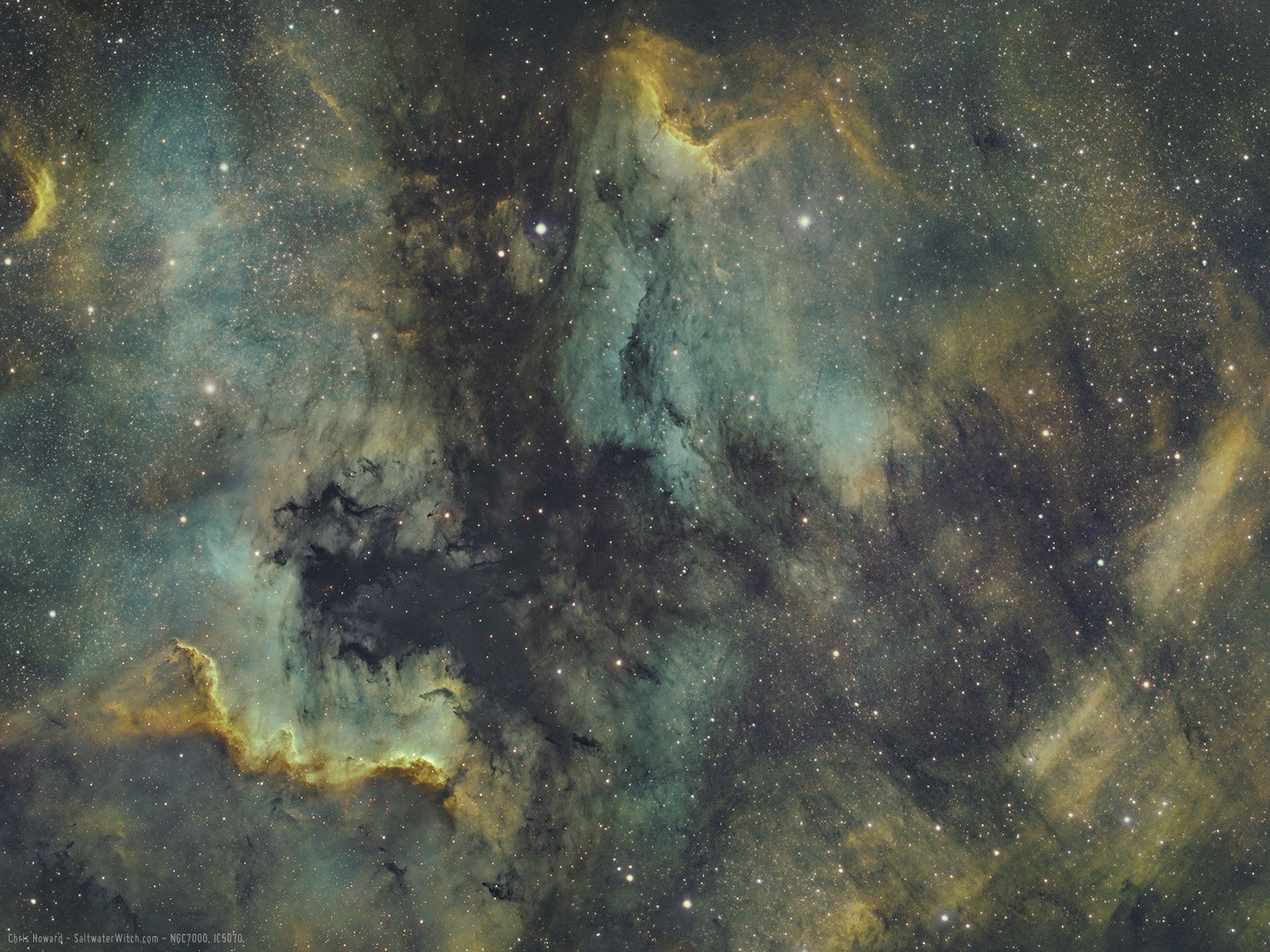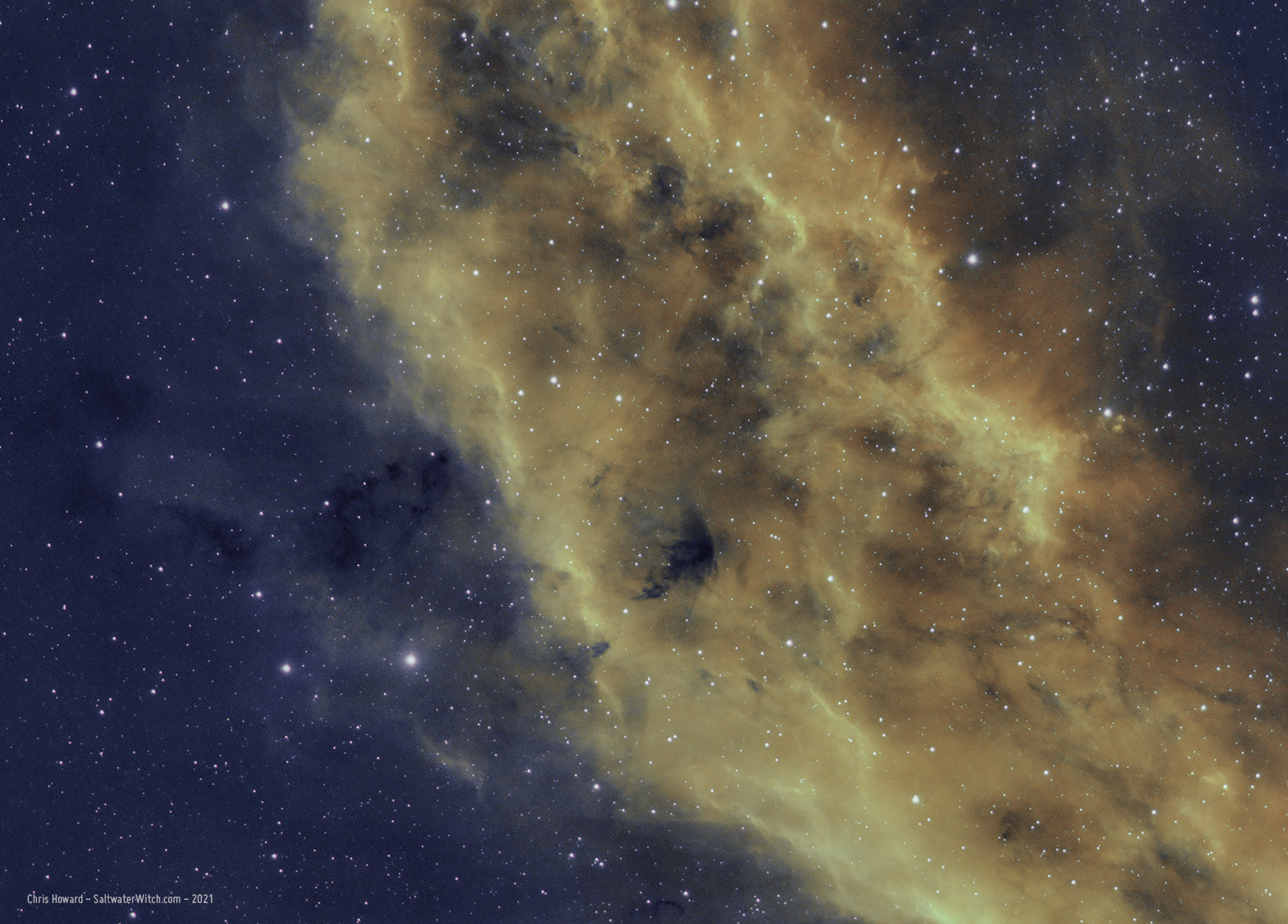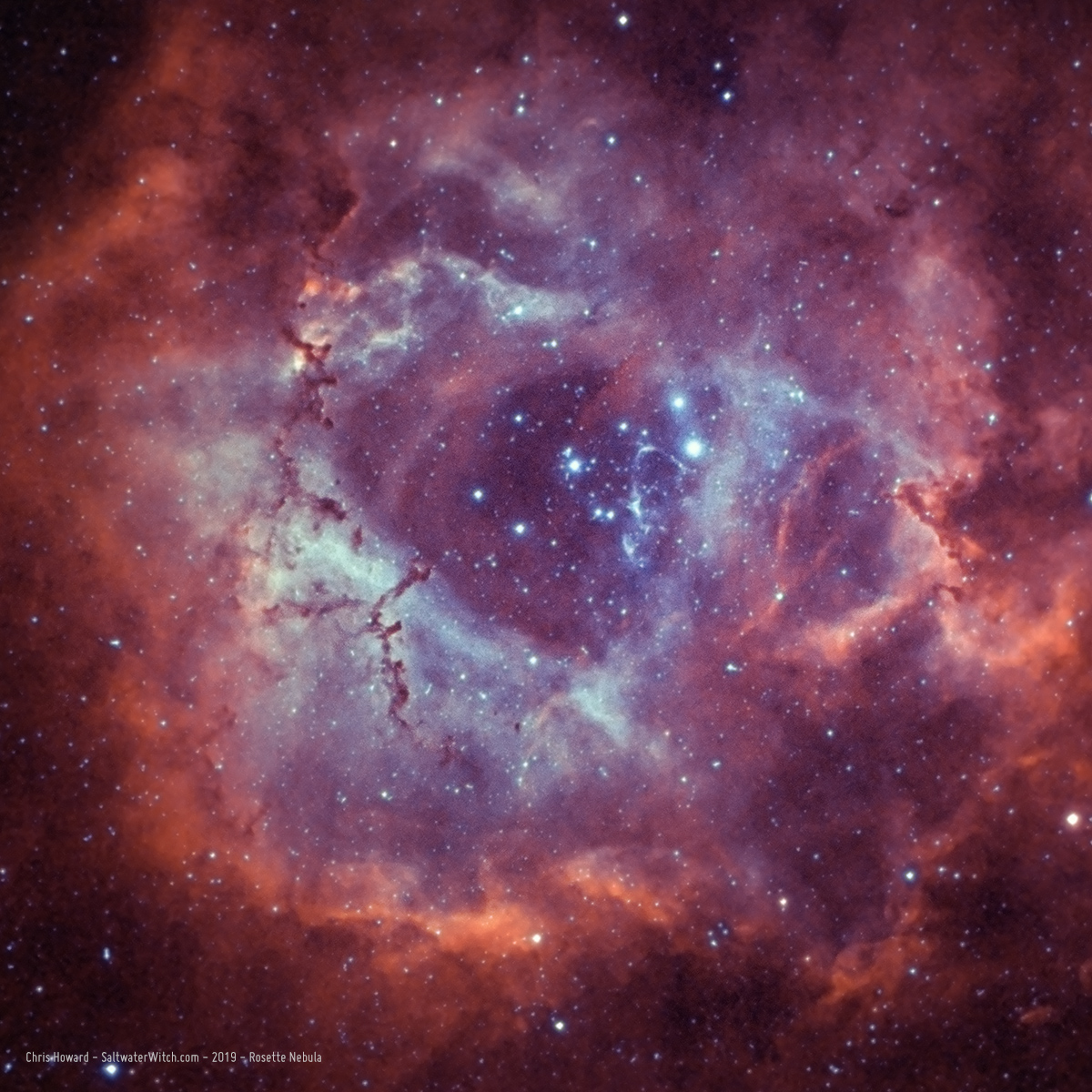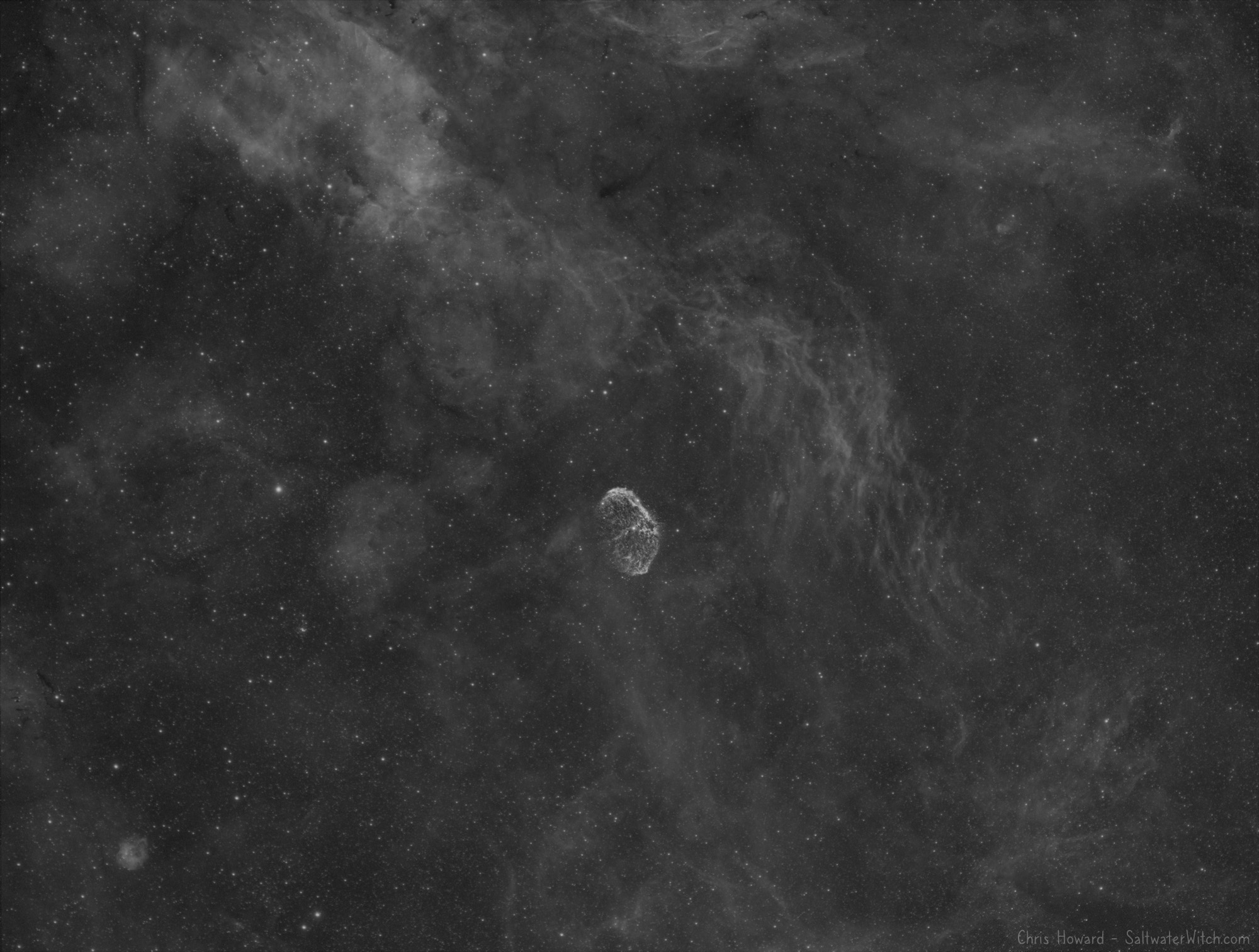The Crescent
NGC 6888, the Crescent Nebula in Cygnus, is mostly made up of ionized hydrogen with a filmy envelope of oxygen (not present in this Ha-only data). Its longest side spans about 25 lightyears, or about 235 trillion kilometers (146 trillion miles), which at only 5000 lightyears away, is a pretty good-sized deep sky object. I spent the entire night capturing hydrogen-alpha data, over 60 subs, 53 of which I used in this stack. I will come back on another night to capture the OIII data. Notes: William Optics SpaceCat51 apochromatic refractor, ZWO ASI1600MM-Pro monochrome camera cooled to -10C, 53 x 300-second subframes (about 4.5 hours of data) stacked in DSS, ZWO AM5 EQ mount, ASIAir Plus controller. (I ordered the ASIAir early August—backordered, and it arrived a couple weeks ago. This is only my second time out with the Air, and I can already see this being be my away-from-home controller).
Cropped to focus on NGC 6888 (above), here's the full FoV from the SpaceCat and ASI1600:
Posted September 17, 2022
The Iris Nebula
The Iris Nebula (NGC7023, Caldwell 4) is a reflection nebula in Cepheus. Notes: 51 x 240 second subs. Apertura 8 inch f/4 800m FL Imaging Newtonian, ZWO ASI071MC color camera, GSO Coma Corrector, SkyWatcher EQ6-R Pro mount, Stellarmate/Raspberry Pi 4 running INDI/Ekos/KStars.

Posted May 20, 2022
NGC 7000, IC 5070
North America Nebula (NGC 7000, left) and Pelican Nebula (IC 5070, top right) in the constellation Cygnus. Narrowband in the SHO palette. 68 x 240 second subs in Ha, OIII, SII. I kept the Hydrogen (green) levels pretty even.

Posted April 30, 2022
NGC 6820
NGC 6820 (Sh2-86) in hydrogen-alpha narrowband. This emission nebula in the constellation Vulpecula is made up of one vast pillar and several not-so-vast pillars of dark molecular dust and gases that have been eroded by the driving stellar winds and intense radiation of the star cluster NGC 6823 (above NGC 6820 in this rotation). Did someone say, "Bok globules"? Yeah, we got those, small dense chunks of dust and gas (hydrogen, carbon, helium, silicates, etc.) that lead to star formation. Of course, small is relative in this case. You can probably take a dozen copies of our entire solar system, including the Kuiper Belt and Oort Cloud and easily fit them all inside most. I gave this monochrome image a hint of vintage tint, a bit or warmth, to counter the core temperatures of Bok globules, which are thought to be some of the coldest objects in the universe. It also makes the image appear a bit brighter.

Posted June 11, 2021
NGC 1499 (California Nebula) Reprocess
While the clouds and rain hang about, I'm reprocessing some data from late last year. False color imaging is fascinating, and I'm retrying the bi-color, Hydrogen-alpha and Sulfur 2 made up of Red and Blue with equal parts Green. The dark clouds of interstellar dust and pockets of hydrogen stand out more this time. NGC1499 is an emission nebula in the constellation Perseus, about 1000 lightyears away from us. This is the central region of the California Nebula, so that means the interstellar version of Fresno is somewhere in there. 

Posted May 23, 2021
Rosette Nebula and Surrounding Region
From the imaging run last night. The Rosette Nebula (NGC 2237) in the Constellation Monoceros is another deep sky object I typically capture every year--at least once! Trailing Orion across the sky, it's over a 100 light-years across and about 5000 lightyears away from us. 50 x 240 second sub-exposures in Ha. Gear notes: SkyWatcher EQ6-R Pro mount, William Optics GT81 Apochromatic Refractor 392mm at f/4.7, ZWO ASI1600MM-Pro monochrome camera, Astronomik 6nm filters, Moonlite focuser, Raspberry Pi 4 4GB / 128GB running INDI/KStars/Ekos

Rosette Nebula in the Constellation Monoceros (detail). You're looking at about 360 trillion miles of globules and globulettes—all those dark cloudy bits, running from the bottom middle of this frame to the top right. This is a detail view of my last Hydrogen-alpha image of NGC 2237 where interstellar gas and dust around one side of the Rosette Nebula have condensed into strings of dark cloudlets that block the emission from the core group of stars lighting up the broader background. Several of the stars that make up the cluster NGC 2244 are massive super-hot O-type stars, and these produce the stellar winds and intense radiation that have shaped the Rosette Nebula. To give you a sense of the scale here, pick any of the branches in those dark cloudy structures, or even most of the loose globules of condensing hydrogen. Our entire solar system can easily fit within the width of one of these. And I'm not talking about the orbit of Pluto; I'm using the Oort Cloud as the defining boundary, which would make the diameter of our solar system roughly 1.5 lightyears. In other words you can fit about 240 of our solar systems, lined up one after the other, in the same space as this chain of dark clouds. William Optics GT81 @f/4.7 Astronomik 6nm Ha filter, ZWO ASI1600MM-Pro mono camera.

Posted November 15, 2020
California Nebula in Hydrogen-alpha
The California Nebula (NGC 1499) in the Constellation Perseus is relatively close to us, about 1000 lightyears away in the Orion Arm of our galaxy (Milky Way), and it's roughly a 100 lightyears in length, so what you see here, top to bottom, is about 600 trillion miles of ionized hydrogen. NGC 1499 is a good-sized emission nebula, about 2.5° in length from our view on Earth. To put that into perspective, a full moon is 1/2°, so the California Nebula is about 5 full moons long in the sky.
Imaging session notes: 50 x 240 second subs, stacked in DSS, processed in PS 2021. SkyWatcher EQ6-R Pro mount, William Optics GT81 Apochromatic Refractor 392mm at f/4.7, ZWO ASI1600MM-Pro monochrome camera, Astronomik 6nm Ha filter, Controller: Raspberry Pi 4 4GB / 128GB running INDI/KStars/Ekos.

Posted November 10, 2020
Rosette Nebula
The Rosette Nebula (NGC 2237 et. al.) from my backyard. 28 x 240 secs Ha, 26 x 240 secs OIII. William Optics GT81 APO refractor, ZWO ASI1600MM-Pro mono camera, Astronomik filters, iOptron CEM25P mount, INDI/Ekos/KStars



